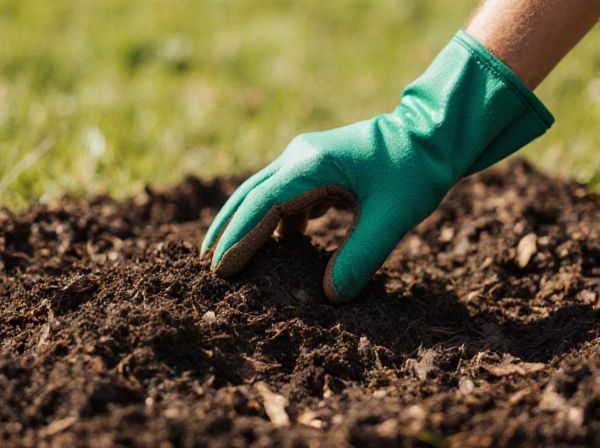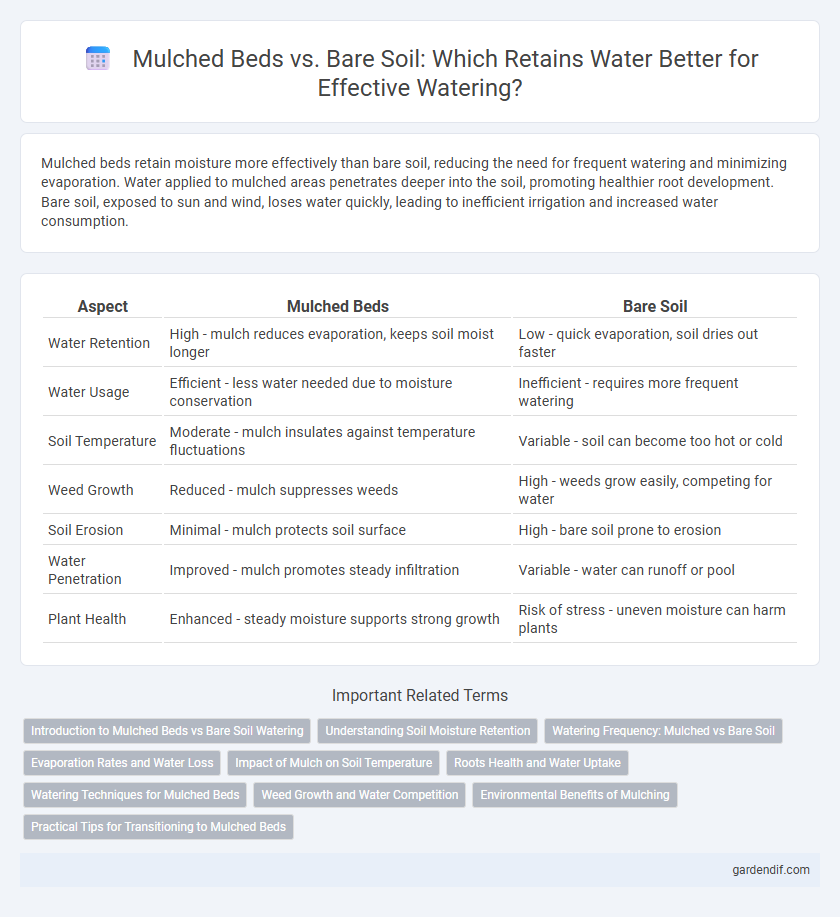
Mulched beds vs Bare soil watering Illustration
Mulched beds retain moisture more effectively than bare soil, reducing the need for frequent watering and minimizing evaporation. Water applied to mulched areas penetrates deeper into the soil, promoting healthier root development. Bare soil, exposed to sun and wind, loses water quickly, leading to inefficient irrigation and increased water consumption.
Table of Comparison
| Aspect | Mulched Beds | Bare Soil |
|---|---|---|
| Water Retention | High - mulch reduces evaporation, keeps soil moist longer | Low - quick evaporation, soil dries out faster |
| Water Usage | Efficient - less water needed due to moisture conservation | Inefficient - requires more frequent watering |
| Soil Temperature | Moderate - mulch insulates against temperature fluctuations | Variable - soil can become too hot or cold |
| Weed Growth | Reduced - mulch suppresses weeds | High - weeds grow easily, competing for water |
| Soil Erosion | Minimal - mulch protects soil surface | High - bare soil prone to erosion |
| Water Penetration | Improved - mulch promotes steady infiltration | Variable - water can runoff or pool |
| Plant Health | Enhanced - steady moisture supports strong growth | Risk of stress - uneven moisture can harm plants |
Introduction to Mulched Beds vs Bare Soil Watering
Mulched beds retain moisture more effectively than bare soil, reducing evaporation by up to 50% and promoting consistent soil hydration. Mulch acts as a protective barrier, moderating soil temperature and preventing crusting, which enhances water infiltration and root absorption. In contrast, bare soil requires more frequent watering due to rapid moisture loss and higher susceptibility to erosion and nutrient depletion.
Understanding Soil Moisture Retention
Mulched beds enhance soil moisture retention by reducing evaporation rates and insulating the soil surface, leading to more consistent water availability for plants. Bare soil tends to lose moisture quickly due to direct exposure to sun and wind, causing frequent watering needs and inefficient water use. Understanding these differences helps optimize irrigation scheduling and promotes healthier plant growth by maintaining balanced soil hydration.
Watering Frequency: Mulched vs Bare Soil
Mulched beds retain moisture longer, reducing watering frequency by up to 50% compared to bare soil. Bare soil loses water quickly due to evaporation, often requiring daily or every-other-day watering in hot climates. Using mulch creates a stable, moisture-rich environment that promotes healthier plant growth with less frequent irrigation.
Evaporation Rates and Water Loss
Mulched beds reduce evaporation rates by up to 50% compared to bare soil, significantly decreasing water loss during irrigation. The organic or inorganic mulch acts as a protective barrier, maintaining soil moisture by limiting direct exposure to sun and wind. Efficient moisture retention in mulched beds enhances water conservation, promoting healthier plant growth and reducing overall irrigation frequency.
Impact of Mulch on Soil Temperature
Mulched beds maintain more stable soil temperatures by insulating the soil from extreme heat and cold, which helps promote consistent moisture retention and root health. Bare soil experiences greater temperature fluctuations that can stress plants and increase evaporation rates, leading to inefficient water use. Research shows mulched soils stay cooler in summer and warmer in winter, optimizing conditions for microbial activity and nutrient availability.
Roots Health and Water Uptake
Mulched beds enhance root health by maintaining consistent soil moisture and preventing evaporation, which promotes deeper water uptake and reduces water stress. In contrast, bare soil experiences rapid evaporation leading to fluctuating moisture levels, causing roots to remain shallow and vulnerable to drying out. Mulching also insulates soil temperature, fostering a stable environment that encourages robust root development and efficient water absorption.
Watering Techniques for Mulched Beds
Mulched beds retain soil moisture more effectively than bare soil, reducing the frequency and volume of watering needed. Drip irrigation or soaker hoses are ideal watering techniques for mulched beds, delivering water directly to the root zone while minimizing evaporation. Applying water slowly and deeply ensures uniform moisture penetration beneath the mulch, promoting healthy plant growth and conserving water resources.
Weed Growth and Water Competition
Mulched beds reduce weed growth by blocking sunlight, minimizing weed seed germination compared to bare soil which allows weeds to thrive and compete for water. The mulch layer helps conserve moisture by reducing evaporation, ensuring more water reaches the desired plants rather than being consumed by competing weeds. In contrast, bare soil increases water competition, forcing plants to struggle for hydration with rapidly growing weeds that deplete soil moisture.
Environmental Benefits of Mulching
Mulched beds conserve soil moisture by reducing evaporation, leading to less frequent watering and significant water savings. Mulch acts as a protective layer, minimizing soil erosion and nutrient runoff, which improves local water quality and supports soil health. By maintaining consistent soil temperature and moisture, mulching reduces plant stress and enhances root development, contributing to more sustainable and resilient landscapes.
Practical Tips for Transitioning to Mulched Beds
Mulched beds retain moisture significantly better than bare soil, reducing watering frequency by up to 50%. When transitioning, gradually increase mulch layers to avoid water runoff and use drip irrigation beneath the mulch to ensure deep root hydration. Regularly monitor soil moisture levels with a moisture meter to adjust watering schedules and prevent overwatering.
Mulched beds vs Bare soil watering Infographic

 gardendif.com
gardendif.com